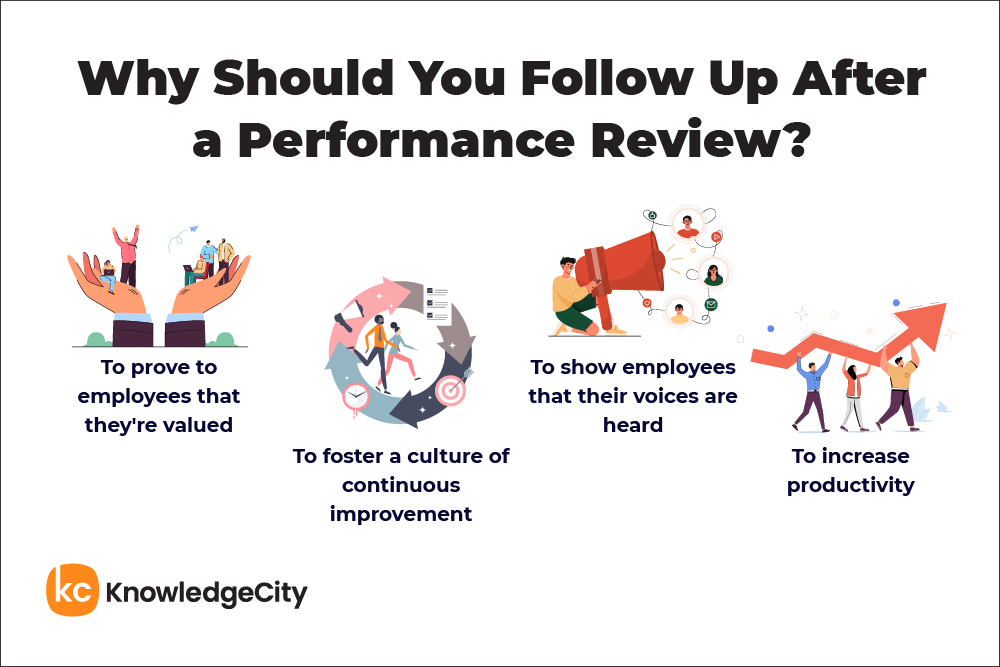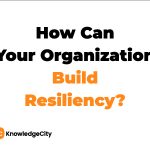Performance reviews are not just feedback sessions but strategic tools for business growth. The journey doesn’t end with the review. For HR leaders and managers, the subsequent steps are pivotal.
This guide will delve deep into the actions leaders should take post-review, emphasizing business plan development and sustaining employee engagement.

What Are Performance Reviews?
Employee performance reviews are systematic evaluations where employers assess employees’ work over a set period. These evaluations, often considered a cornerstone of HR practices, are foundational to individual career development and the company’s strategic growth. They serve as a bridge between management’s expectations and an employee’s understanding of their role, ensuring a mutual understanding of performance standards and outcomes.
Performance reviews comprise several elements. Goal setting establishes future targets that align with the company’s objectives and the employee’s career aspirations. Feedback sessions are a time for reflection, where past performances are discussed, allowing employees to understand their strengths and areas needing improvement.
Evaluations compare an employee’s performance against set benchmarks, clearly showing where they stand. These reviews often involve a combination of self-assessment, where employees evaluate their own performance; peer reviews, which offer insights from colleagues; and managerial evaluations, which give a supervisory perspective.
This multi-faceted approach ensures a holistic view of an employee’s performance. Whether the process is formal, with structured forms and guidelines, or informal, with open conversations, the objective remains consistent: to provide constructive feedback and set a path for future growth.
Performance reviews are instrumental in gauging an employee’s progress. They act as a diagnostic tool, pinpointing areas for improvement and ensuring that individual goals resonate with the broader organizational objectives. A study by Harvard Business Review found that effective reviews can increase employee productivity. This underscores their significance in the corporate landscape.
Furthermore, they serve as a vital communication bridge between employees and management, ensuring alignment in objectives, expectations, and future directions. Beyond feedback, they also play a crucial role in decision-making processes related to promotions, compensations, and even terminations, making them an indispensable tool in HR management.
What To Do After a Performance Review
Post-review, the immediate steps taken by managers can significantly influence an employee’s morale and future performance. It’s not just about the feedback given during the review, but also about the following actions. Expressing gratitude to employees for their contributions and participation in the review process is essential.
This gesture of appreciation can foster a positive work environment and encourage open communication. Moreover, it’s crucial to ensure that the employee comprehensively understands the feedback provided. This clarity is foundational, as it sets the stage for future interactions, performance expectations, and growth trajectories.
Beyond understanding, managers should also equip employees with a clear roadmap or action plan based on the feedback. This can include specific steps, resources, or training to help them address areas of improvement. The aftermath of a performance review is also a time for introspection and strategic decision-making for leaders.
With the insights garnered from the review, decisions ranging from promotions to role changes to potential terminations can be made. These decisions should be rooted in data, ensuring they are transparent, objective, and aligned with the broader organizational goals.
Performance reviews offer data that can shed light on workforce trends, unveil potential leadership candidates, and spotlight areas that require immediate attention. Managers must approach this process with a balanced perspective, ensuring personal biases or preconceived notions don’t skew judgment.
Performance reviews serve as a compass for business strategies. By gauging employee strengths, weaknesses, and potential, leaders can recalibrate targets, reallocate resources with precision, and even steer business directions if required.
For instance, if a review reveals that the majority of the sales team consistently exceeds targets, it might be a cue to set more ambitious sales goals, diversify product offerings, or venture into untapped markets. Performance reviews can be the catalyst for business growth and innovation.
Why Should You Follow Up After a Review?
The period following a performance review is as crucial, if not more, than the review itself. One of the primary reasons for this is the power of consistent follow-ups. Managers engaging in regular follow-ups post-review send a clear message to employees: they are valued.
As highlighted by Quantum Workplace, even a straightforward follow-up gesture can have a profound impact on employee satisfaction. It’s not just about acknowledging their performance but demonstrating that their contributions are integral to the organization’s success.
This act of recognizing and acting upon feedback fosters a culture where continuous improvement is encouraged and ingrained in the organizational ethos. The benefits of regular check-ins and feedback sessions extend beyond immediate satisfaction. Such interactions can significantly bolster employee morale and engagement.
When employees feel that their voices are heard and their feedback is collected and acted upon, it instills a deeper sense of commitment to their roles. Engaged employees are the backbone of any successful organization. They exhibit higher levels of productivity and are more likely to stay with the company, reducing turnover rates. Their positive attitude often permeates the workplace, creating a more collaborative and positive environment.
This sense of being valued and having a clear purpose can transform the workplace dynamic, fostering a sense of community and shared purpose. The ripple effects of consistent follow-ups are far-reaching. In the long run, they can lead to tangible organizational benefits. Reduced turnover rates mean lower hiring costs and a more experienced workforce.
Increased productivity directly impacts the bottom line. Furthermore, a culture emphasizing continuous improvement is more adaptable to market changes and challenges. Additionally, these follow-ups can help in spotting potential leaders early on. Employees who are responsive to feedback, proactive in their improvement, and consistently perform well can be groomed for leadership roles, ensuring the organization has a robust leadership pipeline.
Tips for Performance Review Follow-Ups
The aftermath of a performance review is a pivotal time, and the steps taken post-review can significantly influence an employee’s trajectory and overall morale. One of the most effective strategies is to establish regular check-ins. These aren’t just cursory meetings but focused sessions where managers can monitor employees’ progress based on the feedback provided.
It’s an opportunity to understand if the employee faces any challenges implementing the feedback and if they require additional resources or support. Scheduled check-ins act as a reminder that feedback is a continuous process, not a one-off event. This consistent engagement ensures that feedback is delivered and actively worked upon, leading to tangible performance improvements.
Open communication is the bedrock of effective follow-ups. In today’s digital age, platforms like LinkedIn and others have highlighted the significance of post-review dialogues. Allowing employees to share their reflections, concerns, or clarifications post-review fosters a two-way feedback mechanism. This open channel ensures no ambiguity in feedback and that managers and employees are on the same page.
Over time, this can lead to better alignment between employees and management, fostering a collaborative environment where feedback is welcomed and acted upon.
Lastly, how reviews and follow-ups are conducted holds immense importance. The process should be a balanced blend of constructive feedback and forward-looking guidance. It’s not just about pointing out areas of improvement but also charting a path for growth.
Managers play a crucial role here, and it’s imperative they are trained to deliver feedback that empowers rather than demotivates. Feedback should be growth-centric, focusing on development and future potential.
Consistency is key. Whether it’s the frequency of reviews, the metrics evaluated, or the feedback process, ensuring uniformity across the organization is essential. This ensures fairness and reinforces trust in the review process, making it more effective and impactful.
Maintaining Employee Engagement Post-Review
Employee engagement doesn’t culminate with the conclusion of a performance review. The post-review phase is where the real work begins. One of the most immediate and impactful ways to maintain engagement is through recognition and rewards. When employees see that their hard work and contributions are acknowledged, it instills a sense of pride and motivation.
Such gestures, whether they manifest as a monetary bonus, a promotion, or even a public acknowledgment, serve as powerful affirmations of an employee’s value to the organization. Recognizing and celebrating achievements reinforces positive behaviors and sets a precedent for excellence within the team, driving overall performance.
In the wake of a performance review, there’s also a golden opportunity to invest in employee development. Reviews often highlight areas of improvement and skill gaps. Instead of merely pointing them out, proactive organizations use these insights to tailor training and development programs. Companies can cultivate a more skilled, competent, and confident workforce by addressing these gaps.
Customized training, based on real feedback, ensures that learning interventions are not just generic but highly relevant, targeted, and more impactful. Beyond training and recognition, the broader workplace environment plays a pivotal role in sustaining engagement. A supportive, nurturing environment where employees feel they have the tools, resources, and support to grow is indispensable.
It’s about creating a space where employees feel they belong and are valued. This sense of belonging extends beyond just job roles. It encompasses understanding and addressing the holistic needs of employees.
Whether it’s providing flexibility for a better work-life balance, opportunities for lateral movement and exploration within the company, or platforms for continuous learning and personal growth, a holistic approach ensures employees remain motivated, loyal, and deeply engaged with the organization’s vision and goals.
Performance reviews are strategic linchpins that can shape the trajectory of individual careers and organizational growth. As this guide has illuminated, the journey begins after the review. Post-review steps can profoundly influence employee morale, engagement, and overall productivity.
For HR leaders and managers, the key lies in understanding that performance reviews are not isolated events but part of a continuous cycle of feedback, action, and growth. Recognizing and rewarding efforts, investing in targeted employee development, and fostering a supportive work environment are not just best practices; they are essential strategies to harness the full potential of performance reviews.
In today’s dynamic business landscape, performance reviews can be the catalysts for innovation, growth, and success. They bridge the gap between managerial expectations and employee performance, ensuring alignment with organizational objectives.
By embracing the strategies outlined in this guide, HR leaders and managers can ensure that performance reviews are not just annual rituals but powerful tools that drive business success, employee satisfaction, and a culture of continuous growth.
Subscribe to Our Newsletter
Join 80,000+ Fellow HR Professionals. Get expert recruiting and training tips straight
to your inbox, and become a better HR manager.

 Chuk Otakpor
Chuk Otakpor 










